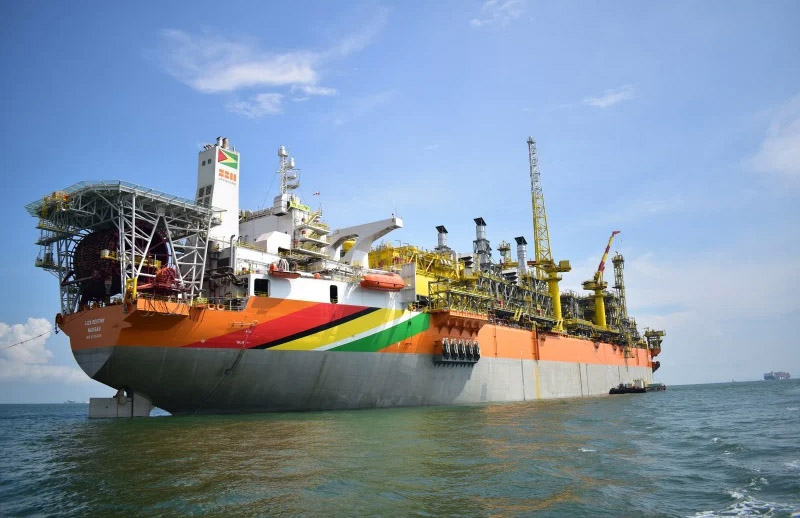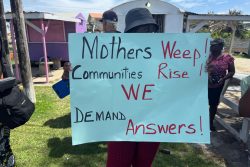The EPA has renewed the Environmental Permit for ExxonMobil’s Liza 1 development in the Stabroek Block offshore Guyana for five years even as the company continues to commit flaring violations owing to the failed gas compressor onboard the Liza Destiny FPSO.
The Liza 1 permit expired yesterday and the renewal would see it remaining valid until May 30, 2027.
According to a statement from the Environmental Protection Agency (EPA), the renewal is entirely in keeping with the Environmental Protection Act Cap 20:05, and comes following careful consideration of Esso Exploration and Production Guyana Limited’s (EEPGL) compliance with the first iteration of the Environmental Permit for the Liza 1 Project.
The Liza 1 project was the first petroleum development to be permitted offshore Guyana and has not been without challenges. The Liza Destiny Floating, Production, Storage and Offloading (FPSO) platform has encountered major problems with its gas compression equipment resulting in environmentally-damaging gas flaring. The gas compressor failed in the middle of the night on January 27, 2021 according to Exxon.
To date, the issue has not been resolved and Exxon continues to flare above permissible levels.
Following the malfunction, the gas compressor and other key parts from the FPSO were sent to Germany for repairs. A few weeks later, it was announced that logistics for its departure from Germany were being finalised following the successful completion of repairs, upgrades and mechanical testing of the compressor by MAN Energy Solutions, the equipment’s manufacturer, with quality assurance and control by experts from the vessel’s owner SBM Offshore as well as Exxon.
On April 13, ExxonMobil announced that its third phase of testing of repaired gas compression equipment on the Liza Destiny had failed and that this had resulted in production being slashed to 30,000 barrels. However, several days later the Company said that it had begun ramping up output and that a solution was at least three months away during which controversial flaring would occur. The gas compressor was sent to Houston, Texas in the United States for repairs.
With the compressor having had to be repaired twice during the early part of this year, the EPA modified the Environmental Permit for the Liza Phase 1 Development Project mandating EEPGL to pay for gas flaring once it continues beyond a 14-day period.
Exxon has indicated that it would replace the gas compressor by the end of this year but environmentalists have been calling for the EPA to revoke the permit until the company can become compliant but those calls have fallen on deaf ears. The EPA has remained silent on the issue.
Further conditions
In its statement yesterday, the EPA said that “progressing from the knowledge and experience gained during the course of this project, the renewed permit specifies further conditions and standards which will ensure that all environmental and social safeguards are taken for the protection of human health and the environment.”
The EPA said that the permit strictly prohibits routine flaring and venting while specifying that flaring is only permissible during commissioning, start-up and special circumstances. It added that the permit also goes further to require the Permit Holder to pay US$50 per tonne of carbon dioxide equivalents (CO2e) emitted as a result of flaring in excess of permitted periods.
“This marks the highest sum to be levied in the event flaring is above stipulated limits and payable in these circumstances, progressing from US$30 under the first Environmental Permit (modified) for the Liza Phase 1 Project,” EPA said.
The permit also ensures that EEPGL is held liable for all costs associated with clean-up, restoration and compensation for any pollution damage which may occur as a consequence of the project.
“EEPGL is also required to have Financial Assurance which includes a combination of Insurance which must ‘cover well control, and/or clean up and third-party liability on terms that are market standard for the type of coverage’, and a Parent Company/Affiliate Guarantee Agreement which indemnifies and keeps indemnified the EPA and the Government of Guyana in the event EEPGL and its Co-Venturers fail to meet their environmental obligations under the Permit. Further, the financial assurance provided must be guided by an estimate of the sum of the reasonably credible costs, expenses, and liabilities that may arise from any breaches of this permit. Liabilities are considered to include costs associated with responding to an incident, clean-up and remediation and monitoring,” EPA explained.
The Permit makes provision for the targeted monitoring of the effects of effluent discharges from the project within the area of influence. EPA says that effluent streams to be monitored include, but are not limited to, produced water, bilge water, cooling water and grey water. Additionally, the permit requires the submission of the effects of these discharges every six months along with the submission of safety case information, including a risk assessment prior to the drilling and development of wells.
The permit now mandates Exxon to establish and maintain a grievance mechanism in keeping with the World Bank’s Approach to Grievance Redress in projects. This is to ensure that complaints from individuals and communities who may be affected by the project are received and addressed.
There is a requirement for reporting the same and what actions were taken to address the grievances to the EPA.
The full text of the renewed Environmental Permit for the Liza Phase 1 Project is available for download on the EPA’s website at www.epaguyana.org.










